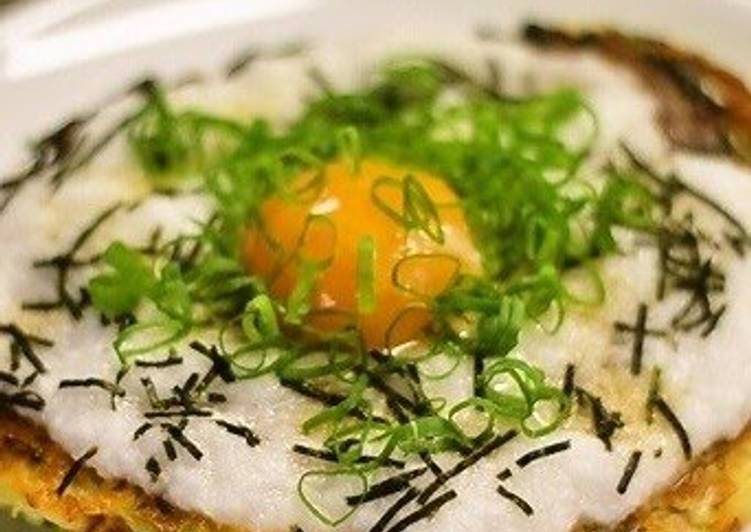Seafood Okonomiyaki with Nagaimo Yam. Okonomiyaki (お好み焼き) is sometimes called "Japanese savory pancake" or "Japanese pizza", but personally, I think it's more like a dish between savory pancake and frittata. Chinese cuisine uses Nagaimo (Chinese yam) and I hope one day Asian grocery stores in the Netherlands will. Okonomiyaki o-konomi-yaki is a Japanese savory pancake containing a variety of ingredients.
 Using Traditional Nagaimo or Yamaimo - For the Grated Yam.
Okonomiyaki is getting slowly more popular outside of Japan.
It's often described as a Japanese pizza, but it's more like a savory pancake.
You can cook Seafood Okonomiyaki with Nagaimo Yam using 17 ingredients and 8 steps. Here is how you achieve it.
Using Traditional Nagaimo or Yamaimo - For the Grated Yam.
Okonomiyaki is getting slowly more popular outside of Japan.
It's often described as a Japanese pizza, but it's more like a savory pancake.
You can cook Seafood Okonomiyaki with Nagaimo Yam using 17 ingredients and 8 steps. Here is how you achieve it.
Ingredients of Seafood Okonomiyaki with Nagaimo Yam
- Prepare 120 grams of Okonomiyaki mix.
- It's 140 ml of Cold water.
- You need 220 grams of Cabbage.
- Prepare 10 grams of Tempura crumbs.
- It's 2 tbsp of Red pickled ginger.
- Prepare 40 grams of Thinly sliced pork belly.
- You need 2 of Eggs.
- It's 4 grams of Sakura shrimp.
- Prepare 100 grams of Mixed frozen seafood.
- Prepare of For the toppings:.
- You need 1 of Shredded nori seaweed.
- Prepare 160 grams of Nagaimo (grated).
- It's 1 dash of Green onions or scallions.
- Prepare 2 of Egg yolks.
- Prepare of For the soy sauce dressing:.
- You need 2 tbsp of Soy sauce.
- It's 1 tbsp of Mirin.
Nagaimo is a starchy root vegetable, which can be known under the names taro root or under that annoying generic term for any starchy root vegetable unfamiliar to to. My mum makes okonomiyaki with prawns, bacon, shallots and cabbage and it's my absolute favourite meal. The thing about okonomiyaki is to use good quality meat and fresh ingredients. I also just store buy the Kewpie's mayonaise and Otafuku Japanese Pancake Okonomiyaki.
Seafood Okonomiyaki with Nagaimo Yam instructions
- Combine the okonomiyaki mix with very cold water and mix until just no longer floury. If you dissolve the powder too much, it will become sticky, so be careful..
- Cover with plastic wrap and chill in the refrigerator for 2 hours. Meanwhile, cut the cabbage into 3-5 mm strips and finely mince the pickled ginger..
- Place the batter, cabbage, egg, tempura crumbs, and pickled ginger into a bowl and mix together using cutting motions. Mix while incorporating air into the batter; don't knead all the air out..
- Heat a frying pan and cook the okonmiyaki. Top the batter with pork slices. While the batter is still soft, tidy up the sides. Cook over low heat for about 5 minutes and then flip it over..
- After flipping, cook over low heat for another 8 minutes. Don't push down on the top of the okonomiyaki. While it's cooking, grate the yam..
- Flip over the okonomiyaki once more and cook for 2 minutes..
- Once it's done, transfer it to a plate and coat it with the soy sauce mixture. Top with plenty of grated yam. Serve it up from the frying pan, so that it can be enjoyed piping hot!.
- Drizzle soy sauce on top of the grated yam. Sprinkle with shredded nori and chopped green onion. Place an egg yolk in the center to finish..
Okonomiyaki comes from combining two Japanese words "okonomi" and "yaki", meaning "as you like it, grilled." As implied, this versatile recipe makes a perfect tabletop cooking recipe - you can almost do no wrong! Note About Nagaimo Yam: Nagaimo is a type of Japanese mountain yam that is slimy when grated. Authentic okonomiyaki includes grated nagaimo (similar to a yam) that adds a creamy texture to the batter and if you can't find it, feel free to omit it! You can add whatever you like to the batter with common additions being pork belly, shrimp, octopus, calamari, oysters, soba noodles, udon noodles. Okonomiyaki is mainly associated with the Kansai or Hiroshima areas of Japan, but is widely available throughout the country.